The 9mm Luger cartridge is the most popular handgun centerfire round in the market today. It’s easy to understand why: The 9mm is a powerful number with high velocity and good accuracy potential, and it can offer deep penetration with the proper loads. Also, the 9mm is controllable in compact handguns by shooters with modest experience, and many very experienced shooters favor the 9mm as well. At the same time, the 9mm has a well-documented string of failures with non-expanding loads and loads lacking sufficient velocity and energy to ensure penetration. This just proves all jacketed-hollow-point bullets are not created equal, and too little penetration may not stop an assailant. The ideal load should have a balance of expansion and penetration. The 147-grain 9mm has been criticized by some for lacking expansion potential. The 147-grain load originally was designed to meet FBI requirements for deep penetration and barrier penetration. Expansion was modest. Many 147-grain loads still meet this criteria, while others demonstrate greater expansion. A new choice is the 135-grain bullet weight. This projectile is designed to provide greater velocity than the 147-grain JHP while offering greater penetration than the popular 124-grain expanding bullet.
9mm Luger Load Performance Data
| Gun: Glock 19X | Ave. Velocity (fps) | Muzzle Energy (ft.-lbs.) | Ave. Accuracy (in.) | IPSC Power Factor | Expanded Width (in.) | Retained Weight (gr.) | Water Penetration (in.) |
| 135 Hornady FlexLock | 1044 | 327 | 1.9 | 141 | 0.48 | 135/100% | 24 |
| 135 Federal Hydra-Shok Deep | 1035 | 321 | 2.4 | 140 | 0.79 | 133/98% | 22 |
| 147 Federal HST P9HST2 | 1006 | 330 | 2.2 | 148 | 0.68 | 147/100% | 22 |
| 147 Federal HST +P P9HST4 | 1030 | 346 | 2.3 | 151 | 0.70 | 147/100% | 20 |
| 147 Buffalo Bore Standard | 1006 | 330 | 2.3 | 148 | 0.75 | 146/99% | 21 |
| 147 Remington Golden Saber | 940 | 288 | 2.4 | 138 | 0.70 | 147/100% | 24 |
| 147 Winchester PDX1 Defender | 980 | 313 | 2.2 | 144 | 0.57 | 147/100% | 20 |
| 147 Fiocchi JHP | 952 | 296 | 1.9 | 140 | 0.46 | 147/100% | 24 |
| 147 Buffalo Bore HC Flat Point | 1060 | 367 | 2 | 156 | 0.36 | 147/100% | 48+ |
| 147 DoubleTap JHP | 1121 | 410 | 2.5 | 165 | 0.54 | 147/100% | 22 |
| 147 Hornady XTP 90282 | 955 | 298 | 1.9 | 140 | 0.55 | 147/100% | 22 |
| 147 SIG Sauer Elite V-Crown | 962 | 302 | 2.3 | 141 | 0.57 | 147/100% | 20 |
| 150 Federal Micro HST | 870 | 252 | 2.5 | 131 | 0.60 | 150/100% | 20 |
| 165 DoubleTap Equalizer | 960 | 338 | 10.5 | 158 | .55/.355 | 158/96% | 20/18 |
| Notes: Average Velocity and standard deviation readings were obtained by firing four five-shot strings over a Competition Electronics Pro Chrono. Ambient temperature: 86 degrees. Elevation: 815 feet above sea level. l The accuracy figures are the average of two five-shot groups. For accuracy, we fired the test gun from a benchrest at a 15-yard target. l To calculate IPSC power factor, multiply bullet weight in grains by the velocity in fps, then divide by 1000. l The retained-weight column shows the recovered bullet weight as a percentage of the actual bullet weight. | |||||||
We tested two 135-grain loads along with ten 147-grain JHP loads and a single 150-grain JHP as well as a heavyweight 165-grain combination. For those living in a true four-season climate that find themselves likely to face heavily bundled adversaries, these loads offer optimal performance. Anyone needing penetration against light cover might consider these loads. A follow-up question would be are they the best choice for personal defense? We believe that some of the 147-grain loads provide a good choice for personal-defense use compared to light-bullet loads with less expansion. The HST, as an example, offers excellent expansion and deep penetration in water.
We used a new Glock 19X as a test gun. The barrel length at about 4 inches is a compromise between service pistols and subcompact handguns. We fired three cartridges of each load to average expansion and penetration in water. We also fired three five-shot groups for accuracy at 25 yards. The remaining rounds were fired for function testing. During the test, there were no function problems of any type. Accuracy was likewise good in every case, with some loads being more accurate than others.
Buffalo Bore Standard Pressure 147-grain JHP 24I
GUN TEST GRADE: A
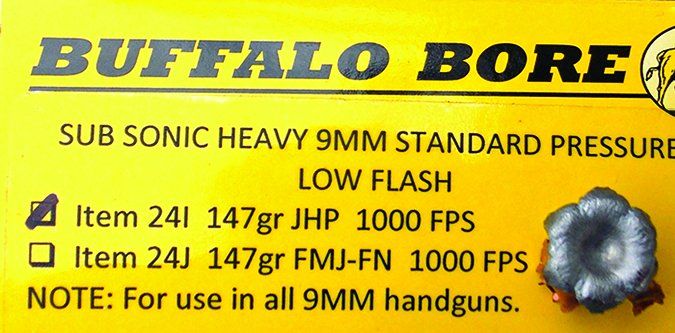
We bought these for $27.36/20 at BuffaloBore.com. This is a standard-pressure-rated load with plenty of momentum. Velocity is 998 fps. Accuracy is good. For some reason control was no more difficult than the slower loads, perhaps because of fast-burning powder, but most likely the 9mm’s general pleasant firing characteristics. While the Fiocchi and Winchester loads had less recoil, we did not find the Buffalo Bore load daunting at all. The question is, do you believe in one hard hit or two or three softer hits and use a +P load? Only the shooter may answer that question, and it depends upon personal ability. The Buffalo Bore load is controllable by those who practice, and it offers good penetration and expansion without +P pressure. Penetration was 21 inches of water. The jacket comprised part of the expanded diameter at an impressive 0.75 inch.
Federal Premium Hydra-Shok Deep 135-Grain PD9HS5H
GUN TEST GRADE: A
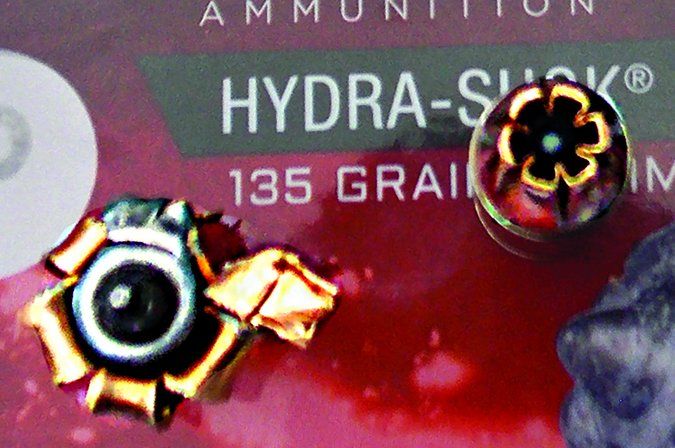
We bought this for $20/20 at LuckyGunner.com. This new loading, introduced within the past few months, isn’t the same as the previous 135-grain Low Recoil Federal cartridge. The bullet design is optimized for penetration, and in our test, we got an average of 22 inches of penetration. The Hydra-Shok bullet features a fold-over crimp on the jacket, which we believe is designed to keep the bullet jacket from opening too soon. Velocity is higher than expected at 1035 fps. Total expansion was the greatest of any load tested at 0.79 inch; however, this was due to a part of the jacket extending from the 0.59-inch mushroom. That shard would still be effective regardless.
Federal Premium HST 147-Grain P9HST2
GUN TEST GRADE: A
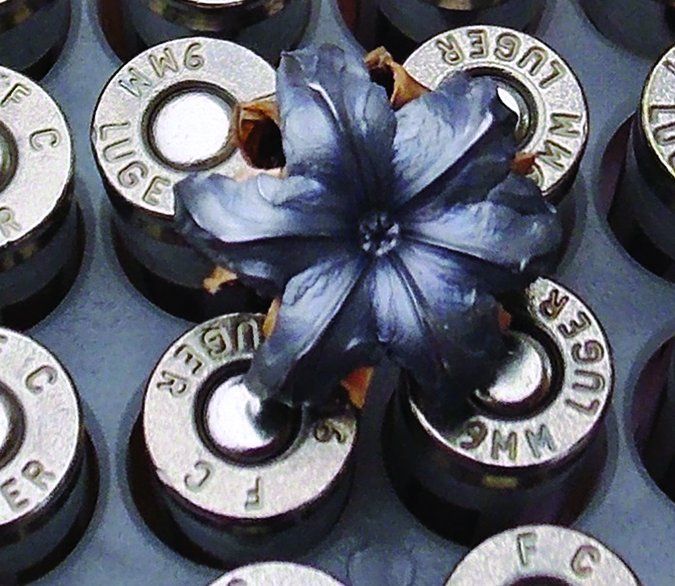
We bought this for $35/50 rounds from LuckyGunner.com. The 147-grain bullet features the popular HST design, which is intended as an improvement over the Hydra-Shok. The HST offers an advantage in barrier penetration. We do not test barrier penetration, but expansion in water was very good and so was penetration. This load proved accurate and exhibited a clean powder burn. We felt that the HST provided optimum performance. This is a load that would convince shooters to adopt the 147-grain load over the 124-grain JHP. At 1006 fps with 22 inches of penetration and 0.68-inch recovered diameter, this is a good choice.
Federal Premium HST +P 147-grain P9HST4
GUN TEST GRADE: A
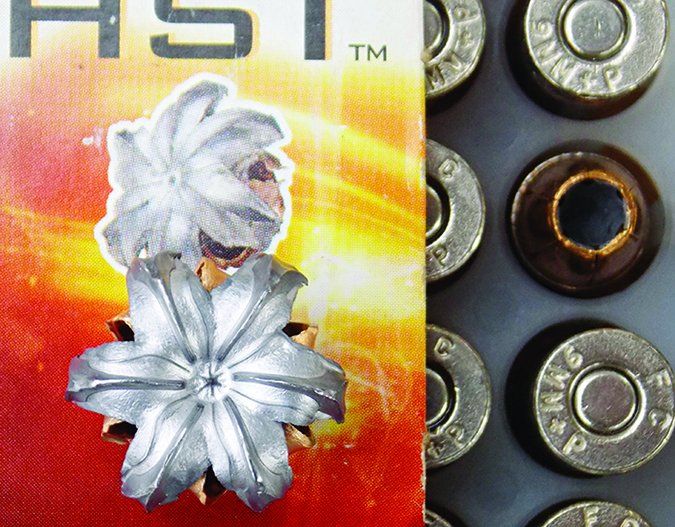
We bought this for $24/50 rounds from AmmunitionDepot.com — a good buy on this load. This appears to be the same bullet used in the standard-pressure loading. The HST +P is an answer to those looking for increased velocity and performance in the 147-grain weight. However, the standard-pressure load is faster than almost all standard-pressure 147-grain loads anyway, which usually average 930 to 980 fps, so Federal did something there. On average, the 147-grain HST +P is 24 fps faster than the standard-pressure loading. This may not seem worthwhile, but we did not expect bullet performance to be as different as it was. Two inches less penetration was achieved with a bullet that expands to .70 versus .68. For civilian versus law-enforcement shooters, this performance might be a better choice, but when a non +P load offers good performance, there is little incentive to add pressure. No increase in recoil was noted.
Hornady Critical Duty FlexLock +P 135-Grain 90226
GUN TEST GRADE: A
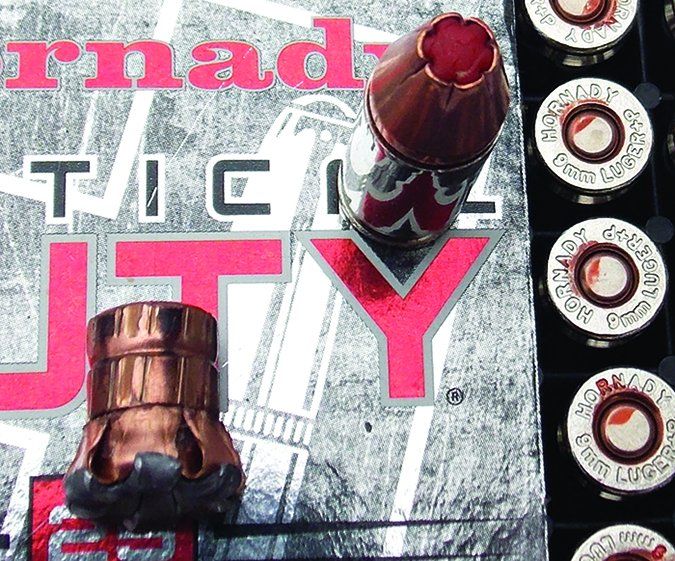
We bought this for $22.50/25 rounds from LuckyGunner.com. This load offers excellent barrier penetration, according to Hornady and agency testing. Our water test showed a bullet that drove to 24 inches in water testing and expanded consistently to 0.48 inch. (Bullet #2 made a dent in the fifth jug; #3 was stuck in the #4 jug’s outer jacket.) Every bullet looked exactly the same, with the most consistent expansion of the test. The Hornady bullet offered excellent accuracy as well, tying the Fiocchi loading for most accurate and only in second place for accuracy by splitting hairs. The Hornady bullet has plenty of penetration, and we feel that this load is a serious contender for law-enforcement use. If traveling in country inhabited by big cats and feral dogs, this is a good choice. The needs of law enforcement and the needs of home-defense shooters may be different, but this is an outstanding loading for either group.
Winchester PDX1 Defender 147-Grain S9MMPDB1
GUN TEST GRADE: A
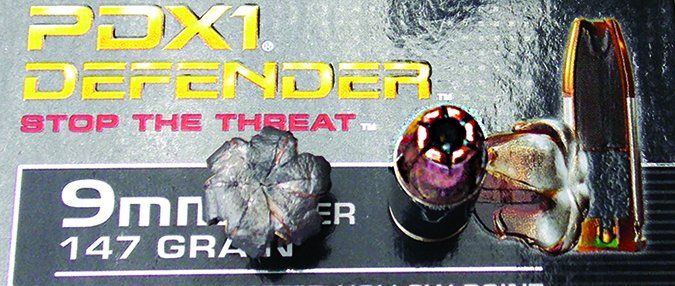
We bought this for $20/20 rounds at TargetSportsUSA.com. The Winchester PDX Defender is a bonded-core design like the rest of the loads tested. The Winchester load breaks 940 fps and offers good control. Accuracy is good, and the powder burn is clean. Muzzle flash is limited. In other words, this is a service-grade loading. Penetration is optimal, and the bullet expands to 0.57 inch reliably. The Winchester load is a viable choice with good performance.
Remington HD Ultimate Defense 147-Grain Brass-Jacketed HP 28946
GUN TEST GRADE: A
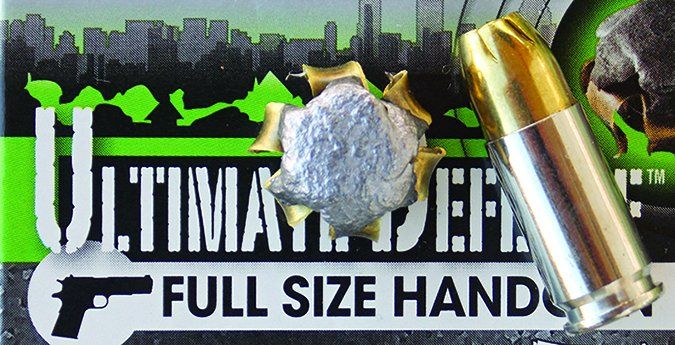
We bought this for $26/20 rounds from MidwayUSA.com. The Golden Saber used a brass jacket over a lead bullet. The jacket is actually designed to be part of the wound mechanism. It is designed for the rigors of law enforcement, but non-LE shooters can buy it. The Golden Saber expanded to .70 inch, excellent results. Velocity was 940 fps and penetration a deep 24 inches. The Golden Saber is accurate and fired a total of 50 trouble-free rounds.
Buffalo Bore Outdoorsman Hard Cast Lead Flat Nose 147-Grain 24L/20
GUN TEST GRADE: A
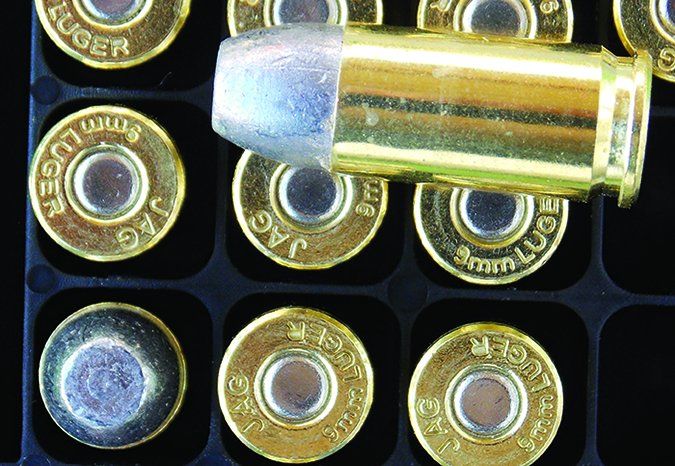
We bought this one for $26/20 at MidwayUSA.com. This isn’t a jacketed-bullet load, but is rather a hard-cast flat-nose bullet intended for defensive use against larger animals. Many folks use the 9mm for personal defense, and rather than purchase a Magnum revolver for occasional use in the wild, they might find it handy to load the 9mm with high-penetration bullets. FMJ loads typically cut a small wound path, but the Flat Point should create more damage. We found the Buffalo Bore load is a strong choice at a solid 1060 fps average. We cannot tell you the true water penetration because we gave up at 48 inches. We tried to capture the bullet in 42 inches of water, or seven jugs, and it sailed through. Next, we tried eight jugs at 48 inches, the limit of the fixtures we use for holding the water jugs. It sailed through. The exit hole was more ragged than we have seen with FMJ loads. We felt that this is more than adequate penetration. We are not rating this loading compared to the others because it is unique, but it certainly fits in with the deep-penetrating 9mm line of this report. In an urban situation, it’s probably not the right choice because it might strike a person beyond your target. Penetration is at least in 357 Magnum territory.
DoubleTap +P 147-Grain JHP
GUN TEST GRADE: A
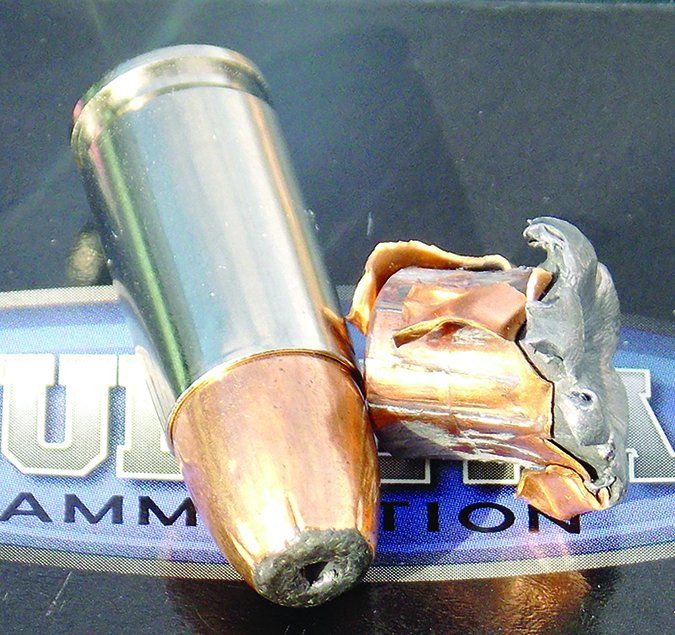
We bought this for $22.71/20 at DoubleTapAmmo.net. This is the fastest load tested at 1121 fps. That is 38 Super category. Yet, there were no adverse pressure signs in the spent cases. The 147-grain JHP penetrated 22 inches of water and expanded to 0.55 inch. We did not recognize the bullet used, but it appears to be a design intended to limit early penetration. We do not think it is a bonded design, although the jacket and bullet stayed together. This load certainly caused a ruckus in the water jugs. We think that a combination of careful powder selection and long-loading the bullet allowed the company to achieve this velocity. This load is worth considering, but it should be fired in a service pistol such as the Glock 19X, not a compact handgun, to maximize its effects.
SIG Sauer Elite V-Crown 147-Grain E9MMA3-20
GUN TEST GRADE: A
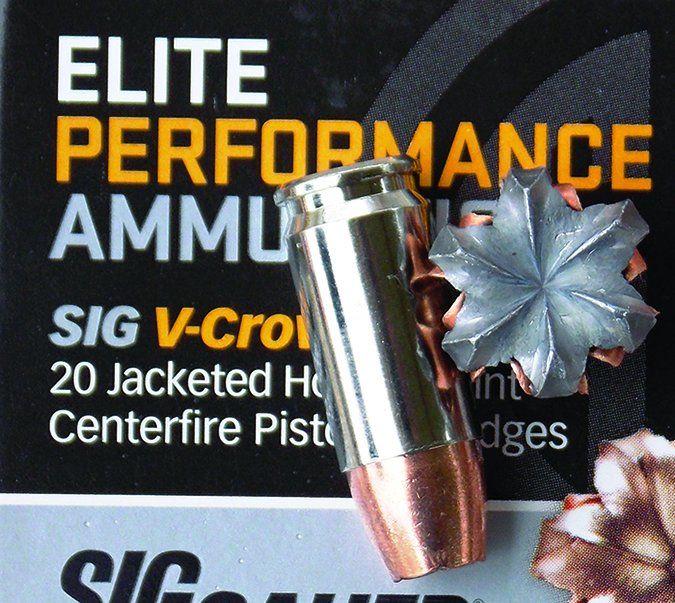
This was available for $15/20 at MidwayUSA.com, or about 75 cents a round, one of the lower-priced choices in the test. For a new company, SIG Elite has achieved a footprint in the market quickly. The V-Crown hollow point is one reason. The 147-grain V-Crown averaged 962 fps, right in the league with several other loads with practically identical velocity. The V-Crown was also a good performer, with penetration of 20 inches and expansion to 0.57 inch. The loading exhibited a clean powder burn and good accuracy.
Hornady Custom XTP 147-Grain 90282
GUN TEST GRADE: A
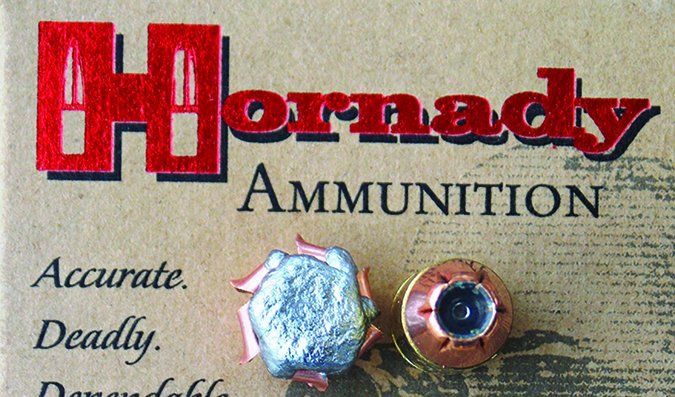
The Extreme Terminal Performance (XTP) bullet features a good balance of expansion and penetration, with penetration considered the more vital component. The 147-grain XTP is well balanced and often shows good accuracy at long range. In this case, the XTP clocked 955 fps. Penetration in water was a very uniform 24 inches. Expansion was 0.52 inch. This loading is also accurate, and controlling it isn’t difficult.
Federal Premium Micro HST 150-Grain P9HST5S
GUN TEST GRADE: A-
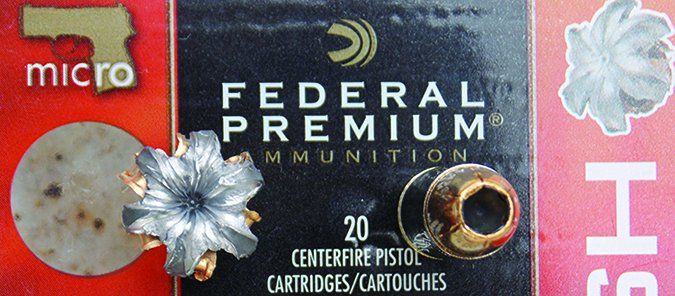
This cost $24.75/20 rounds at LuckyGunner.com. It is a specialty load intended for use in compact handguns. It is less difficult to get a heavy bullet to consistently perform well with cycle reliability at velocity below 1000 fps versus a low-recoil lower-energy 115-grain bullet. Federal managed to set the velocity at 870 fps and maintain good function, and this bullet is designed to open at modest velocity. Barrier penetration was not a consideration in the design. The bullet expands to 0.60-inch caliber while penetrating to 20 inches. The 150-grain HST cannot be faulted on the basis of expansion. Recoil is low. For personal-defense in smaller handguns, this load makes the grade. We rated it down a half grade because its energy is low compared to the other offerings.
Fiocchi 147-Grain JHP 9APDHP
GUN TEST GRADE: A- (Best Buy)
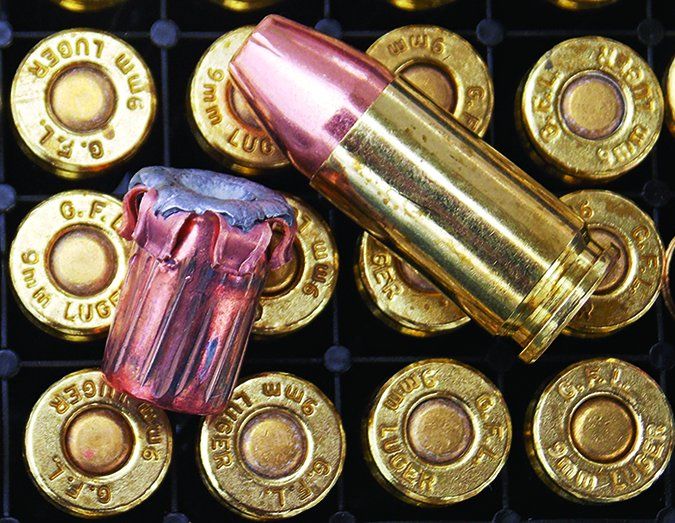
We bought this one for $20.75/50 rounds at LuckyGunner.com. It cost $13/20 rounds at MidwayUSA.com. This is an affordable loading in a 50-round box and a fair price in the 20-round box. Even if you choose another load to wear out in public, this one strikes to the same point of impact as other 147-grain loads and offers a good price point for practice. The Fiocchi load at 952 fps average is pleasant to fire and is the most accurate loading tested. The Fiocchi JHP heavyweight offers what many are looking for, a balance of expansion and penetration that favors penetration. Penetration is a long 24 inches, stopping in the skin of the fourth water jug consistently. Expansion is 0.46 inch. If this load is your choice, you’ll have an emphasis on control, accuracy as well as penetration. While we prefer more expansion, this load does what a 147-grain JHP is designed to do. We rated it down a half grade based on expansion, but we can’t overlook that this loading costs less for 50 rounds than 20 of most of the competing loads.
DoubleTap 165-grain JHP
GUN TEST GRADE: B
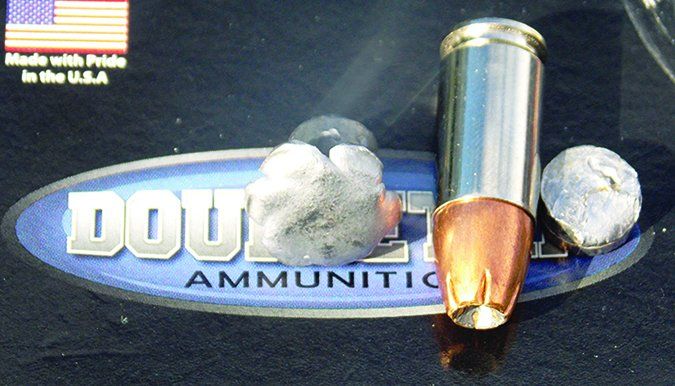
This cost $25 for a 20-round box at DoubleTapAmmo.net. This is an unusual load, a 115-grain JHP over a 50-grain solid disk. DoubleTap offers these in the Equalizer line. Velocity would necessarily be low due to the heavyweight combination, we thought. The 115-grain JHP isn’t going to expand as much at low velocity and should penetrate more deeply, we felt, and the testing bore some of this out. The load clocked 965 fps, which is plenty fast considering this is the heaviest bullet tested. The 115-grain JHP penetrated to 23 inches and expanded to 0.54 inch while losing the jacket. The 0.355-inch disk penetrated to 16, 16, and 18 inches in our testing. Multiple-projectile loads are not intended to be super-accurate, and we saw that is SOP for this design. The projectiles were a finger-width apart at 7 yards, and, surprisingly, at 10 yards, they were perhaps two finger widths apart. At 20 yards, the story was different, with the two projectiles 4 to 6 inches apart and neither striking to the point of aim. We wanted to be fair and consider the potential of this loading despite its drawbacks. With the slower velocity than usually posted with a 115-grain JHP, this bullet penetrated deeper, expanded less, and lost its jacket. The disk penetrated to 17 inches on average. The problem would be this isn’t a load for hostage rescue or precision shooting, but then personal defense or home defense seldom is. A multiple-projectile load would exhibit a five-shot group of perhaps 10 inches, which is outside our acceptable range, but then the load met its design parameter.
Our Team Said:
When testing 9mm Luger ammunition in the past, we have experienced up to a 100% deviation in penetration, with some 77- to 124-grain loads reaching 6 to 7 inches in water and others penetrating 12 to 16 inches. Here, penetration generally ranged from 18 to 24 inches. So, for self defense, choose any of the A or A- ranked rounds and see what you like in your gun. The top five have excellent performance. The Winchester PDX is the most controllable, while the DoubleTap load has the greatest energy. But the Buffalo Bore standard pressure, DoubleTap +P , SIG V-Crown and Federal HST 9mms are also excellent choices.
Written and photographed by Gun Tests staff.



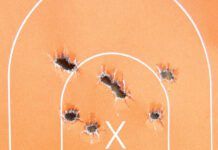














Todd,
This is one of the greatest, most concise, and most informative articles I’ve ever read concerning 9mm 147 ammo. I’m a huge fan of the Federal HST 147+P JHP(Now discontinued). I’ve now taken a liking to Underwoods 147+P JHP offering that motors along @ supposedly 1125 FPS & 414 FPS.
Any thoughts on Underwoods 147+P or their line-up in general?
Blessings your way,
R.L.Turner
When the 147 grain. and other heavy bullet 9mm loads started coming into common usage, in the late 80’s/early 90’s, it was supposedly because the bullet was “sub-sonic” (bullet velocity below the speed of sound), so that it would function more effectively through suppressors, often fitted on the sexy and exciting HK MP-5 subgun, a popular status symbol used by many police SWAT types. It was somewhat quieter through a suppressor but hardly a more effective bug zapper. Stopping power is still a matter of shot placement, and the suspect’s resilience to pain, frequently effected by drugs like PCP or methamphetamine and/or mental illness. Some people are just bullet sponges and must be hit multiple times despite what they are shot with. Use a round that runs reliably through your particular firearm and that you can best control and keep on target. I’m not a tough guy, I’m not an expert, I’m not trying to impress anyone. I have just been in a tiny bit of combat and a small hit beats a big miss every time. A cock roach doesn’t care about bullet weights.